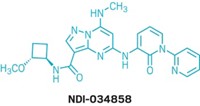Advertisement
Grab your lab coat. Let's get started
Welcome!
Welcome!
Create an account below to get 6 C&EN articles per month, receive newsletters and more - all free.
It seems this is your first time logging in online. Please enter the following information to continue.
As an ACS member you automatically get access to this site. All we need is few more details to create your reading experience.
Not you? Sign in with a different account.
Not you? Sign in with a different account.
ERROR 1
ERROR 1
ERROR 2
ERROR 2
ERROR 2
ERROR 2
ERROR 2
Password and Confirm password must match.
If you have an ACS member number, please enter it here so we can link this account to your membership. (optional)
ERROR 2
ACS values your privacy. By submitting your information, you are gaining access to C&EN and subscribing to our weekly newsletter. We use the information you provide to make your reading experience better, and we will never sell your data to third party members.
Business
R&D Collaboration Targets Alzheimer's
Boehringer Ingelheim, Vitae team up for a second time
by Michael McCoy
June 15, 2009
Germany's Boehringer Ingelheim will collaborate with Vitae Pharmaceuticals, a small-molecule drug discovery firm based in Fort Washington, Pa., on the research and development of beta-secretase inhibitors for the treatment of Alzheimer's disease.
Under the agreement, Vitae will receive cash payments, an equity investment, and research funding totaling $42 million. The firm also will be eligible to receive $200 million in future milestone payments plus other milestone and royalty payments.
The deal is the second between the two firms. In 2007, Vitae received $36.5 million in payments from Boehringer Ingelheim in a collaboration aimed at diabetes and other diseases related to metabolic syndrome.
The new agreement targets beta-secretase, an enzyme involved in the production of amyloid-beta peptide, a major component of the plaques that are associated with memory loss in Alzheimer's patients. Blocking the enzyme could prevent the buildup of such plaques and help slow or stop the progress of the disease, Vitae says. Currently marketed drugs address some of the disease's symptoms but don't delay or halt its progression.
Vitae CEO Jeffrey Hatfield says the collaboration "extends what is already a very successful partnership model with Boehringer Ingelheim." He adds that the deal continues Vitae's business model of "partnering versus relying on the capital markets."
Vitae's core technology is a computational drug design technique it calls Contour. The firm says Contour rapidly designs and optimizes compounds within the binding site of a target protein.



Join the conversation
Contact the reporter
Submit a Letter to the Editor for publication
Engage with us on Twitter